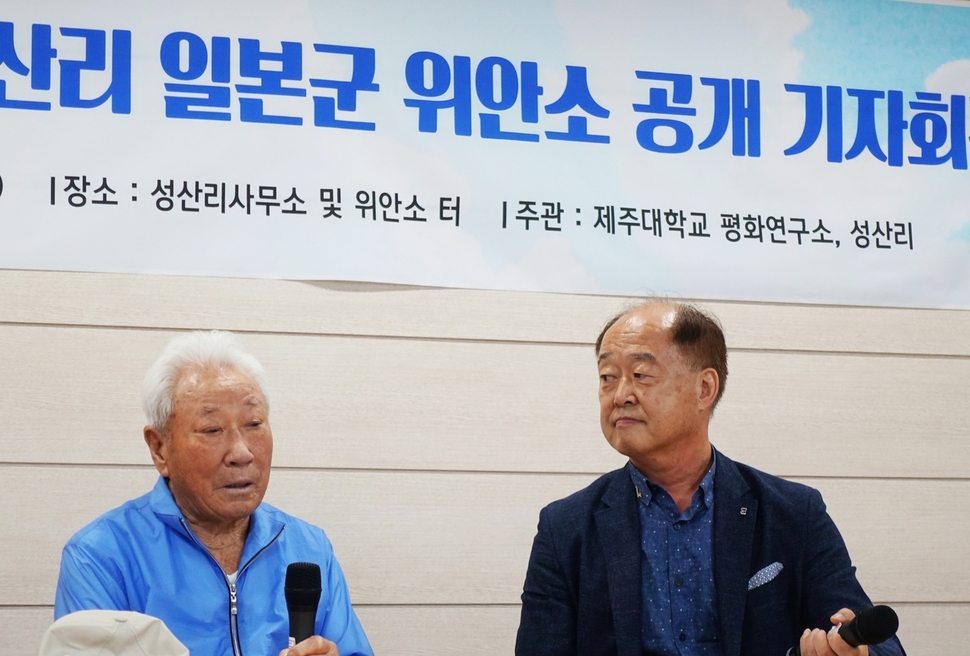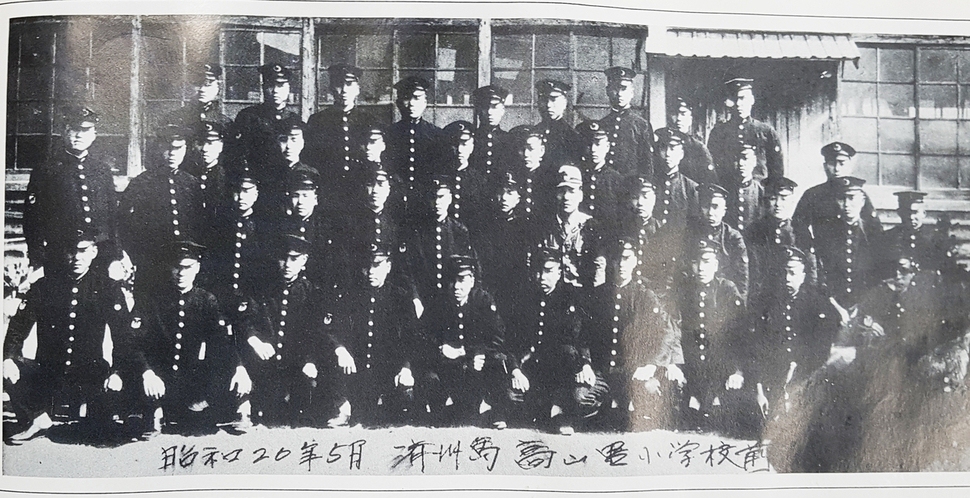Posted on : Jul.9,2019 17:29 KST
 |
|
Oh Si-jong (left) and Jeju National University professor Cho Seong-yoon hold a press conference on Japanese comfort stations on Jeju Island during the Pacific War at Seogwipo, Jeju, on July 8. (by Huh Ho-joon, Jeju correspondent)
|
Oh Si-jong testifies to witnessing Japanese special forces frequent stations
“Comfort stations” providing sexual services for the Japanese military were operated on Jeju Island during the late stages of the Pacific War from April 1945 until Japan’s defeat, an eyewitness claims.
The announcement was made during a “public press conference on the Japanese comfort stations at Seongsan Village during the Japanese occupation,” held at the Seongsan Village Office in the Seongsan township of Seogwipo on July 8 by the Jeju National University Peace Institute (headed by professor Cho Seong-yoon). But with only one witness sharing details and no documentary evidence yet to support the claims, additional investigation appears necessary.
The eyewitness that day, 91-year-old Oh Si-jong, said there were two “comfort stations” operating in his village at the time. One was located in a private home less than 30m from the house where he lived, while the other was in a Japanese-owned inn around 100m from his house, he recalled.
“After special forces with the Japanese Navy moved in, the military requisitioned homes to turn into comfort stations,” explained Oh, who was 16 at the time.
“Each place had five to six women. I don’t know where they came from, but some of them were under 20 years old and others were between 25 and 26, and they wore hanbok [traditional Korean outfits],” he said.
 |
|
The site of a former comfort station in Seongsan Village identified by Oh.
|
“But I couldn’t really see inside the comfort stations,” he recalled.
Explaining his basis for concluding that the houses were comfort stations, Oh said, “I found out because I lived just behind there. I learned that it was being run by Japanese soldiers, and I could see soldiers lining up in front of the comfort station.”
“The women didn’t go around or go out to draw water. [Necessary supplies] were brought by older soldiers [from the Japanese 108th Mixed Brigade],” he recalled.
Oh also said he remembered the comfort station to have been exclusively frequented by “Yokaren” (special forces with the Japanese Navy who were referred to as “human weapons”) rather than ordinary Japanese soldiers.
“I never had any opportunity to speak to the women at the comfort station of the Japanese soldiers, but every day I saw people in full-dress uniform going in and coming out,” he said.
While the press conference that day was based on Oh’s eyewitness account of the comfort stations present at the time, there are unfortunately no accounts from other residents or documentary materials to back up his claims. Of the five individuals born between the 1920s and 1930s met by researchers, the other four besides Oh were unaware of the comfort stations’ presence.
“There have also been accounts of comfort stations in North Korea, Daegu, Busan, and elsewhere,” said Cho Seong-yoon. “We decided to go public despite some shortcomings because Jeju is the first case where we have an eyewitness now and actual locations have been specified.”
“Hopefully, this will be an occasion for increasing our research into the comfort stations established in Korea,” Cho said.
 |
|
A photo of a Japanese special forces battalion taken in Jeju’s Gosan Village in May 1945. (photo from “Yokaren: Human Weapons”)
|
According to a paper published by the researchers, a total of three Japanese Navy coastal special forces bases were positioned on Jeju Island: one on the coast at Seongsan Ilchulbong Peak, another at Sammaebong Peak in Seogwipo, and a third at Suwolbong Peak in Gosan. The 45th Shinyo Squadron, which was deployed on the coast at Seongsan Ilchulbong, was known as the “Murayama unit” and had 50 Shinyo-class suicide motorboats, with 15 tunnels dug on the Ilchulbong coast for this purpose. The unit arrived at the port of Seongsanpo in April 1945. Shinyo-class vessels were wooden-hull boats equipped with explosives, which Japanese Navy special forces members (Yokaren) would ride into US military vessels while still on board to collide with them and damage them in explosions – making the Yokaren equivalent to the “kamikaze pilots of the sea.”
By Huh Ho-joon, Jeju correspondent
Please direct comments or questions to [english@hani.co.kr]











